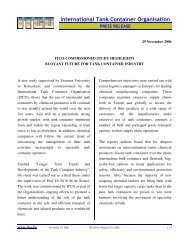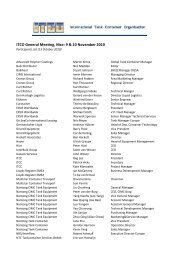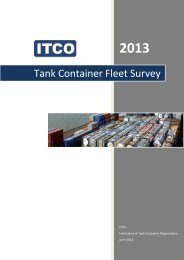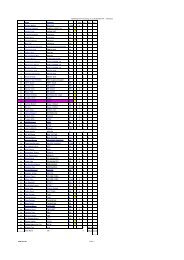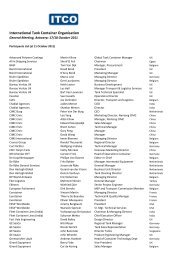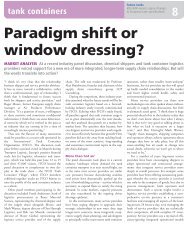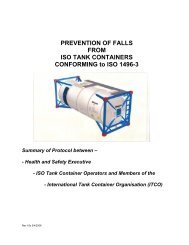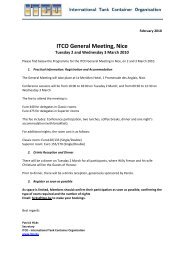Create successful ePaper yourself
Turn your PDF publications into a flip-book with our unique Google optimized e-Paper software.
ICHCA International <strong>Safe</strong>ty Panel Briefing Pamphlet No 30<br />
A5.1.9 General NOS entries covering a group <strong>of</strong> substances or articles meeting the<br />
criteria <strong>of</strong> one or more classes or divisions. When general NOS entries are<br />
made, the actual chemical name (the technical name) must be given in<br />
brackets as part <strong>of</strong> the PSN<br />
Example UN 1993 Flammable Liquid, NOS (Aluminium Martinate)<br />
A5.1.10 A mixture or solution containing a single dangerous substance specifically<br />
listed by name in the dangerous goods list and one or more substances not<br />
subject to regulation is assigned the UN number and proper shipping name<br />
<strong>of</strong> the dangerous substance.<br />
A5.1.11 The exceptions to the above are if the solution is specifically identified by<br />
name in the Dangerous Goods List or if the entry into the Dangerous Goods<br />
List specifically indicates that it applies to a pure substance. If the hazard<br />
class or division or physical state or packing group <strong>of</strong> the solution or mixture<br />
is different from that <strong>of</strong> the dangerous substance, there can be a significant<br />
change in the measures to be taken in emergencies.<br />
A5.1.12 For a solution or mixture where the hazard class, the physical state or<br />
packing group is changed in comparison with the listed substance, the<br />
appropriate NOS entry shall be used including its packing and labelling<br />
provisions<br />
A5.2 Marine Pollutants<br />
A5.2.1 Figure A5.1 shows the mark / placard used for<br />
Environmentally Hazardous Substances (Aquatic<br />
Environment) which are known as marine pollutants<br />
in the IMDG Code.<br />
A5.2.2 Marine pollutants shall be transported under the<br />
appropriate entry according to their properties if<br />
they fall within the criteria <strong>of</strong> any <strong>of</strong> the classes 1 to<br />
8. If they do not fall within the criteria <strong>of</strong> these<br />
classes, they shall be transported under entry;<br />
ENVIRONMENTALLY HAZARDOUS SUBSTANCE,<br />
Figure A5.1<br />
SOLID, N.O.S., UN 3077 or ENVIRONMENTALLY HAZARDOUS<br />
SUBSTANCE, LIQUID, N.O.S., UN 3082, as appropriate, unless there is a<br />
specific entry for the substance in class 9.<br />
A5.2.3 Column 4 <strong>of</strong> the Dangerous Goods List in the IMDG Code provides<br />
information on marine pollutants using the symbol “P”.<br />
A5.2.4 When a substance, material or article possesses properties that meet the<br />
criteria <strong>of</strong> a marine pollutant but is not identified in the IMDG Code, such<br />
substance, material or article shall be transported as a marine pollutant in<br />
accordance with the IMDG Code.<br />
A5.3 Wastes<br />
A5.3.1 Wastes, which are dangerous goods, shall be transported in accordance<br />
with the relevant international recommendations and conventions and, in<br />
particular, where it concerns transport by sea, with the provisions <strong>of</strong> the<br />
IMDG Code.<br />
Page 65 ©ICHCA International Limited



